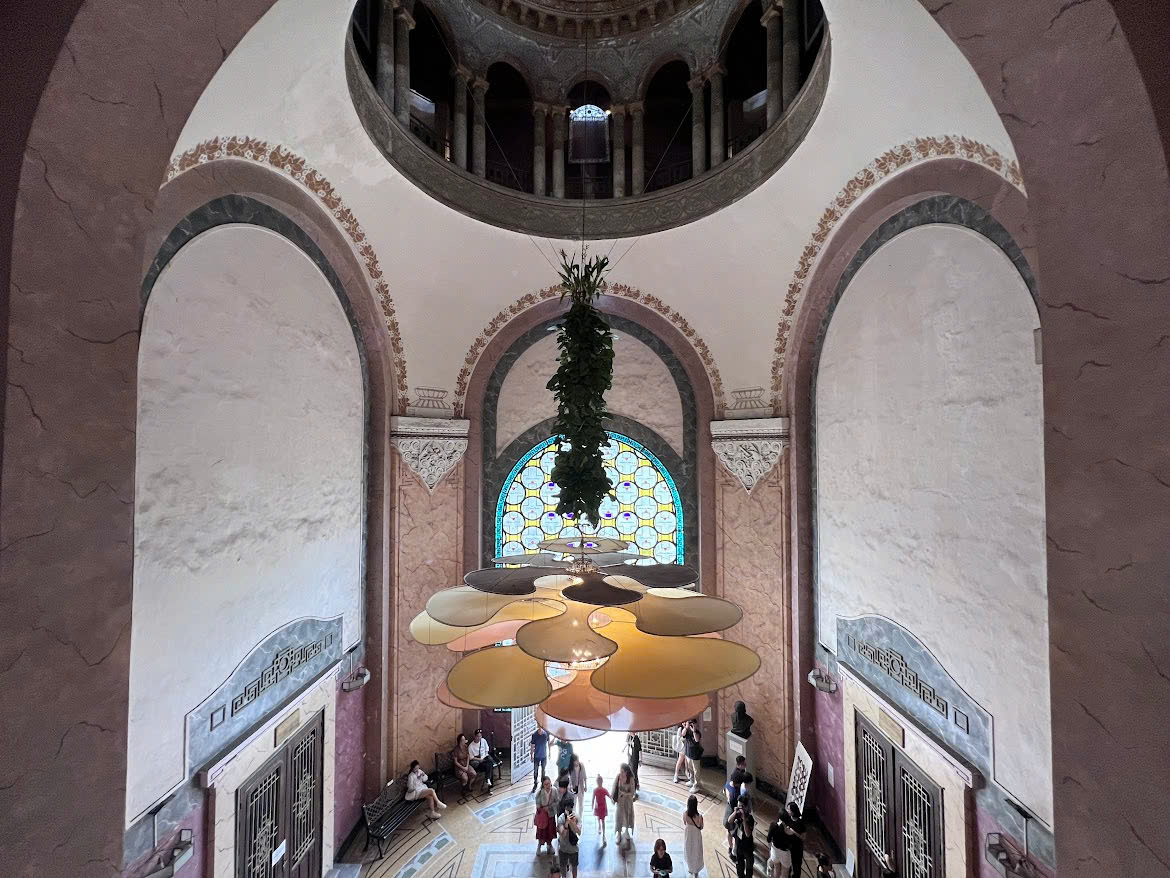
As part of the Hanoi Festival of Creative Design 2024, a conference entitled "Architectural Heritage in the Creative City" was held at the Vietnam National Museum of History this week.
| Foreign visitors respond to the Hanoi Festival of Creative Design 2024. Photo: Huy Pham/ The Hanoi Times |
Running under the theme "Architectural Heritage in the Creative City", the event was jointly organized by the Hanoi Department of Culture and Sports and Architecture Magazine, the organ of the Vietnam Association of Architects.
The city of rich culture
"Giving vitality to the architectural heritage in the contemporary flow" is the goal of the conference, which brings together experts in architecture, history and public memory with the capital's iconic architectural heritage sites in a journey from the past to the present and future.
As a member of UNESCO's Creative Cities Network, Hanoi has gradually moved towards placing creativity and the creative economy at the core of the process of developing a dynamic, inclusive and sustainable city.
In this process, cultural heritage is not only the non-material and material foundation for building a Creative City, but also a factor directly involved in creating the creative spaces of the city.
Architectural relics in particular, as well as cultural heritage in general, are often the sites of community-created, community-nourished, and community-transmitted cultural activity. Therefore, they will contribute to the promotion of community activities, drawing people, and tapping the creativity of all socioeconomic strata if they have a good fit with modern society.
With its status as the country's center for over a millennium, Hanoi is a collection of diverse material traces in which architectural works contribute to a heritage block that makes up the attractive appearance of the city.
| Live performance at Hoa Lo Prison Historical Site. Photo courtesy of the relic site. |
In particular, the relics on the streets of Ly Thai To, Le Thanh Tong, and Trang Tien largely shaped the modern look of Hanoi from the end of the 19th century to the second half of the 20th century.
Turning heritage into economic assets
Hanoi is home to an impressive wealth of cultural heritage, with the Hanoi Department of Culture and Sports reporting a total of 5,922 inventoried relics. These include one World Heritage Site (the Thang Long Imperial Citadel), 21 special national relic clusters, and over 1,700 intangible cultural heritage items that have been cataloged and are under protection.
This rich cultural heritage represents a unique opportunity for Hanoi to attract and engage tourists. The challenge, however, is how to transform this heritage into economic and social drivers that contribute to the city's broader development.
In response to this challenge, several cultural and tourism management bodies have been actively working to develop new experiences based on the city's heritage. A prime example is the Hoa Lo Prison relic, which now offers the highly popular " Sacred Night " night tour. Demand for the tour is so high that reservations often have to be made months in advance. Similarly, the Thang Long Imperial Citadel has introduced the "Decoding Thang Long Imperial Citadel" night tour, which has boosted the number of weekly visitors to 2,000.
| The Indochina Sense Exhibition was held at the Indochina University in celebration of the Hanoi Creative Design Festival 2024. Photo: Huy Pham/ The Hanoi Times |
While these efforts are commendable, much remains to be done to leverage Hanoi's heritage to drive sustainable cultural and economic growth. Achieving this goal will require continued innovation and strategic planning by heritage managers, as well as the cultivation of creative approaches to tourism and cultural preservation.
Initiatives to “awaken” Hanoi cultural legacy
The annual Creative Design Festival is one of Hanoi's key initiatives to "turn heritage into assets."
Speaking at the "Architectural Heritage in the Creative City" conference, architect Hoang Dao Kinh remarked, "Perhaps we have lived in Hanoi for so long that we’ve become indifferent to its treasures, but Hanoi is undoubtedly a city brimming with uniqueness." The Hanoi Creative Design Festival has awakened us so that we don't become apathetic about the city we live in. I appreciate the courage of architects and artists with artworks that use modern science and technology to revive heritage sites."
| The Hanoi Festival of Creative Design is an annual cultural event that showcases the capital's cultural industries and the creativity of its businesses and citizens. Photo: Minh An/ The Hanoi Times |
Architect Nguyen Hong Quang also commented: "The festival is a fascinating space for many beneficiaries, especially the creative community. We have a space to showcase our works, connect disciplines, and introduce new creations. Each work is like an entrance for the public to approach precious gems - architectural heritage sites".
In addition to assessing the role of architectural heritage in the creative city, experts also raised thoughtful questions about the sustainability of the creations that emerge from architectural heritage sites.
Based on past festivals' experiences, Quang says the organizers this year spent a lot of time researching how to produce sustainable works. The pavilions are more visitor-restrained and positioned in stable areas that can hold visitors' attention for longer, such Vietnam National History Museum courtyard.
Pham Tuan Long, Chairman of Hoan Kiem People's Committee, based on his experience in revitalizing many architectural heritage sites in the district, said that it is necessary to have the cooperation of many units to operate and utilize the works after the festival. Hopefully, with the enactment of the Capital Law, many doors will be opened for cooperation to effectively put heritage sites and unique works to use after the festival is over.
The conference gathered systematic perspectives from architectural researchers as well as solutions to breathe life into this heritage. Moreover, it helped to form a knowledge community where the understanding of local heritage is shared among the owners of the city - the people living in Hanoi today.






.jpg)
.jpg)

